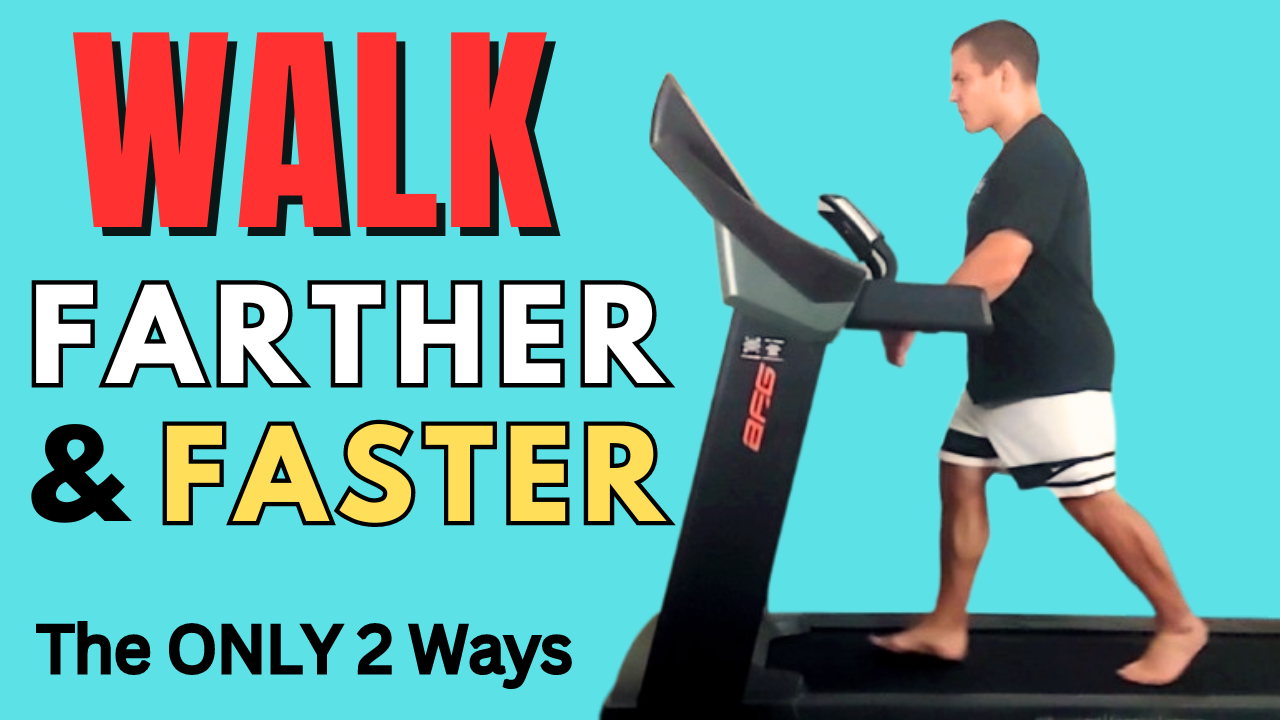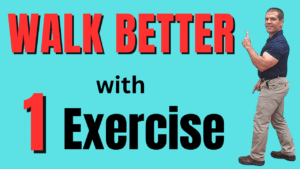Maintaining the ability to walk is one of the biggest concerns among seniors. As a physical therapist, I see many patients in their 50s, 60s, 70s, and 80s. Consistently, one of the biggest concerns is not being able to walk as long or as far as they once used to.
Or they feel like they're lagging behind because they can't walk as fast. They may feel like they're holding their family back, can't go out and do things with their grandkids.
Or can't go walk with their friends because they're slowing everyone else down. That can create social isolation because they don't want to keep everyone else from having a good time.
But there are really ONLY 2 ways to walk faster, and one of them may limit how long you can walk. Watch this video to learn how to walk faster and farther without causing pain or injury.
The ONLY 2 Ways To Walk Faster and Farther
There are literally only 2 ways that you can walk faster.
You can either:
- take more steps in a given period of time
- take longer steps
That yields the equation:
Walking Speed = step length times x cadence
Looking at units of measurement:
Walking Speed is distance / time for example miles / hour, km / hour, or meters / second.
Step length is in distance / step
Cadence is steps / time
So:
(distance/time) = (distance/step) x (steps/time)
You can address one of those factors, or the other, or both. Those are the only two ways to increase your walking speed.
Solution 1: Walk Faster By Taking Longer Steps
Interestingly, when you take longer strides, if you have poor flexibility in either your calves that can create pronation of your foot, which can cause plantar fasciitis, knee pain, or hip pain.
If you have stiff hip flexors, that can cause your back to arch too much because you lack hip extension. That in turn can create back pain or sciatica when walking.
So how do you walk FASTER without sacrificing HOW LONG you can walk due to pain?
To increase your stride length, you need to improve the flexibility in your calves and hip flexors. Additionally, you need to strengthen your hips and glutes so that you can balance on one leg long enough to take a large step.
Fortunately, you can do all of that with just this ONE Exercise To Improve Walking.
Increasing your flexibility, strength, and balance takes time though.
In the meantime, the only other option is to take more steps in a given period of time.
Solution 2: Walk Faster By Taking Quicker Steps
The nice part about taking quicker steps is that it helps you walk faster almost immediately.
Often are shorter steps. They're not big long strides. But if you decrease your step length but increase your step frequency or your cadence, it allows you to walk at the same speed without having to take longer strides.
So the long-term strategy is improving the flexibility in the hip flexors and calves and strengthening your hip muscles so you can take longer strides.
The short-term strategy to walk faster is to take shorter, quicker steps.
You may notice as you move toward a faster walking cadence, you'll move more towards a midfoot strike... and that's OK.
Many people have been taught that you should walk heel-to-toe.
However, that's rather un-natural to do unless you're wearing shoes.
I you look at children starting to learn how to walk or if you look at cultures that are non-westernized where they tend to go barefoot a little bit more, you may notice they hit with more of a whole-foot strike rather than a heel strike. When you hit with your whole foot on the ground, it gives you more surface area to land on, so it makes you a little bit more stable. It also decreases the ground reaction force.
You'll notice that in the #video above that as speed increase, it becomes more natural to hit with a midfoot strike.
Additionally, as speed increases, you'll notice an overall increase in sound from the treadmill, but it's much less overall when you're hitting with more of a midfoot versus a heel strike regardless of speed.
I'll list some notes from the video above, but I suggest that you watch it as written words on a page don't do it justice.
Walking And Running At Different Gait Speeds
Walking 0.5 mph (0.8 km/h)
Note: You notice I'm barefoot in this video, but this is only for demonstration purposes. Always wear shoes when you're on the treadmill.
There's not much noticeable different between a rearfoot and midfoot strike at this speed, but this is much slower than even seniors should walk. You have to be able to walk at 1.14 meters per second (~2.5 miles / hour) to be able to cross a street in time before the light changes.)
Walking 1 mph (1.6 km/h)
This is also a rather slow walking pace. The average walking speed of an adult is about 3 miles per hour at 30 years of age and decreases gradually to 2 miles per hour over age 65. However, that's an average, and there are people who walk much faster than that as well as much slower than that. And it's not uncommon to see patients who actually do walk at one-half to one mile per hour.
Walking 2 mph (3.2 km/h)
Now as we get up to more normal walking speeds, you'll be able to start to see and hear the differences between midfoot and heel strike. That's because you have a larger surface area hitting the ground, and so there's less pressure per unit area.
Walking 3 mph (4.8 km/h)
Moving up to three miles an hour, this is a fast walk for many seniors, but about an average walking pace for a younger person. Again, you can hear the change in volume from heel strike to midfoot. As we start getting faster. You can also start to hear a difference in cadence, how frequent the steps are.
Walking 4 mph (6.4 km/h)
Count the number of steps when the timer starts. Counted 30 steps in 10 seconds with a midfoot strike and 27 steps in 10 seconds with a heel strike.
Multiply that by six to get a minute, and you get 180 steps per minute at the midfoot strike and 27 times six would be about 162 with the heel strike.
Ideally, it is a little better to count for 30 seconds and multiply by 2 so that you have a more accurate estimate, but this just gives you an idea.
Jogging 5 mph (8.0 km/h)
Now this is truly starting to get into running because there's a float phase. One foot is not on the ground at all portions of time, so this is no longer walking per se.
However, some seniors still run or want to be able to play Pickleball or tennis or run around with their grandkids, so I included it just for interest.
Running 6 mph (9.7 km/h)
Notice the running is getting louder, but it's significantly less with a midfoot or flat foot strike versus with the heel strike.
Running 7 mph (11.3 km/h)
If you are a runner, the ideal cadence, is right about 180 steps per minute for most runners, regardless of your speed. So get up to 180 steps per minute. Then to get faster than that, you'd start increasing your stride length.
Running 8 mph (12.9 km/h)
Notice how with a heel strike, the stride is longer but also slower than with a midfoot strike. A heel strike at this point starts to become a little bit painful.
Running 9 mph (14.5 km/h) and 10 mph (16.1 km/h )
I opted out of heel striking because it's too uncomfortable to do it at those speed without shoes.
Conclusion
In conclusion, there are only 2 ways to walk faster: take more steps per unit time, or take longer steps. Taking quicker steps usually will increase your speed immediately while lengthening your stride takes time to develop they flexibility and strength to do it right.
If you live in the St. Louis area and need help to improve your walking or otherwise be more active with less pain, we'd be happy to help you at More 4 Life. Just tap the button below to request an appointment with one of our specialist physical therapists.
Additionally, here are some other posts about exercises for walking that you might enjoy:
How To Improve Walking Gait Instantly Without Exercises
Spinal Stenosis And Walking Problems
3 Ways To Relieve Back Pain When Walking


